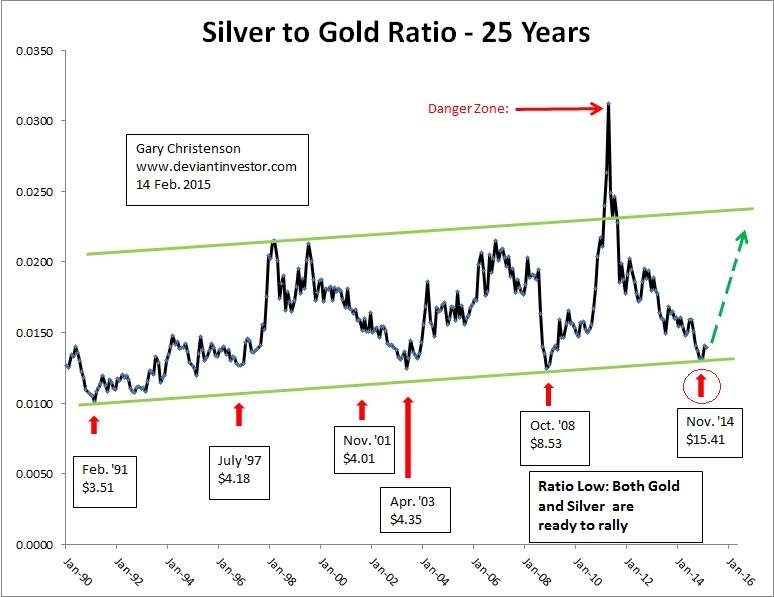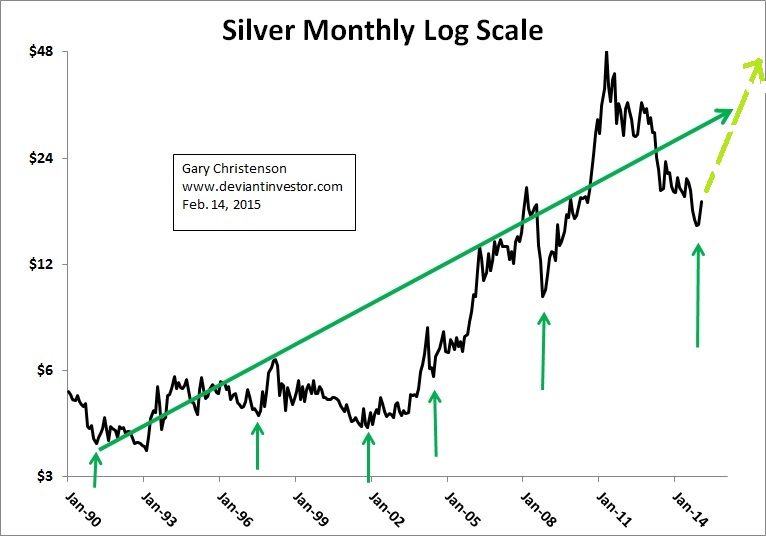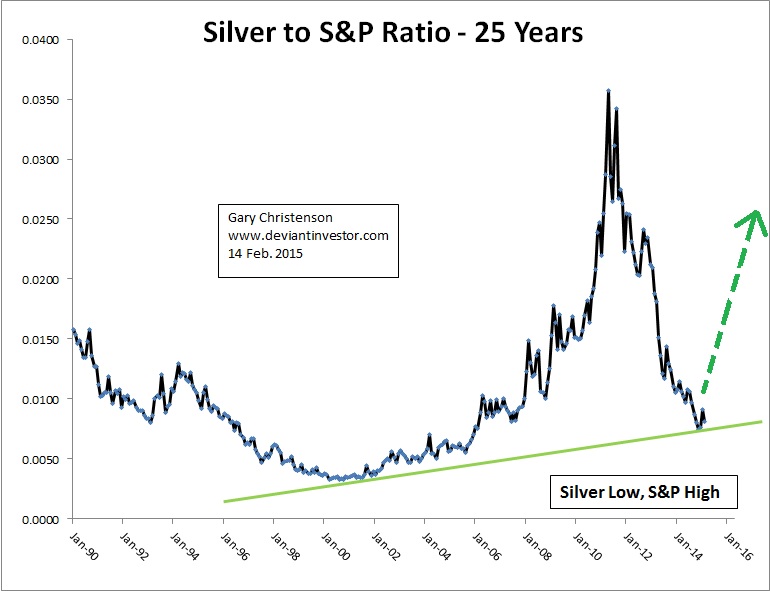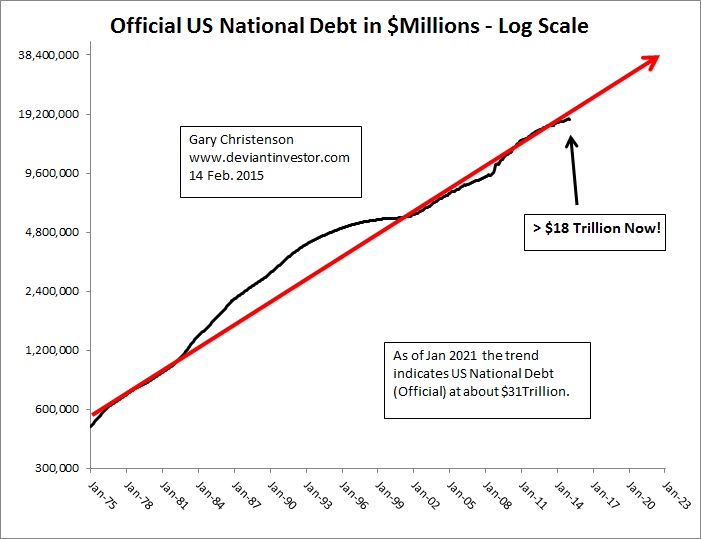Silver and Gold: Why Now?
Commodities / Gold and Silver 2015 Feb 17, 2015 - 04:52 PM GMTBy: DeviantInvestor
 Examine the graph of the silver to gold ratio over the past 25 years.
Examine the graph of the silver to gold ratio over the past 25 years.

- The major lows in silver prices during the past 25 years are marked with red arrows on the graph. They coincide, more or less, with lows in the silver to gold ratio.
- The low in November of last year is indicated by the circled red arrow.
- It seems likely that a lasting low for silver was achieved then.
Examine the graph of silver prices on a log scale for the past 25 years.

- Prices are highly volatile (we all know this).
- Prices are increasing exponentially, which is difficult to see unless you look at long term charts. Many people obsess over the April 2011 peak and the subsequent 70% loss in price, and assume the downtrend will continue forever. It won’t.
- This chart also shows a sequence of lows in silver prices.
Examine the chart of the ratio of silver to S&P prices.

- The ratio was recently at nine year lows.
- The ratio has fallen hard because the S&P has been levitated by QE and silver prices collapsed, especially after the April 2013 meeting in the White House between a group of bankers and the current US President.
- Expect this ratio to move much higher during the remainder of this decade. Given the low readings for the silver to gold ratio and the current low price of silver, we should expect substantially higher silver prices in the next several years.
Examine the 40 year chart of official US national debt on a log scale.

The trend is clearly upward at slightly more than 9% per year. At that rate the official US national debt will exceed $30 Trillion before January 2021, unless our financial system crashes first.
What could go wrong? For intelligent analysis, read:
- Spitznagel: Market Warnings in Plain Sight
- Egon von Greyerz: Current Global Financial System Will Cease to Exist
- Amerman: Wargaming the Greek Crisis.
My very simple perspective is this: In round numbers the US government debt increased by about $1,000,000,000,000 ($1 Trillion) in the single year between October 1, 2013 and October 1, 2014. Government revenue plus borrowed money were spent on the military, social security, Medicare and so much more. But that money is gone and producing NO future revenue, unlike debt that purchases a business which generates income to service the debt.
In simple terms, government took real revenue, spent it, and then added more debt each year. Worse, the US owes compounding interest on the larger debt. Each year the US and many other governments pay interest on the loans (caused by deficit spending) from previous years. The total debt increases rapidly – far too rapidly to be repaid without massive inflation. Hence default via debt repudiation or devaluation of purchasing power is inevitable.
The interest accrues FOREVER since the debt is never paid back, only rolled over. Loaning money to an insolvent government for 30 years makes little sense. It makes even less sense for real investors to loan money at less than 3% per year for 30 years. Hence the Fed buys most of the US debt. The story is much the same globally, except that a portion of the debt in Europe now “pays” negative interest rates. This creates a highly unstable financial system, unless you think that central banks can create more currency each year, loan it to their governments, and prolong the process indefinitely. I think the system becomes more fragile, more dangerous, and more unstable each year.
CONCLUSIONS:
- Silver prices made a multi-year low in November 2014.
- Silver prices have increased exponentially since 1971, just like the national debt, but far more erratically.
- Silver and gold prices will rally much higher for the next several years, unless a deflationary depression (unlikely because central banks can print currencies almost forever) crushes all asset prices. In that unlikely case, I trust silver and gold to hold their purchasing power far better than sovereign debt and most other paper assets.
- Governments will spend more money than they collect in revenue. Deficit spending will accelerate if wars in the Middle-East and Europe expand, which appears likely.
- Central banks will purchase that sovereign debt, because they must, to support the global financial system and prevent the deflationary depression that every central banker and politician fears. Bet on global QE, more inflation, loss of purchasing power, and higher silver and gold prices.
- Unstable systems can “go critical” practically overnight. The big reset might not happen for several more years, or it might occur near Armstrong’s “big bang” point in October of this year.
- Silver and gold, at current prices, are an excellent investment, but more importantly, they are insurance and protection against the probability that our financial system will “go critical” as a consequence of years of Quantitative Easing, Zero Interest Rates, massive fiat money creation, and the deficit spending that has generated about $200 Trillion of global debt.
- Be prepared!
© 2015 Copyright Deviant Investor - All Rights Reserved Disclaimer: The above is a matter of opinion provided for general information purposes only and is not intended as investment advice. Information and analysis above are derived from sources and utilising methods believed to be reliable, but we cannot accept responsibility for any losses you may incur as a result of this analysis. Individuals should consult with their personal financial advisors.
© 2005-2022 http://www.MarketOracle.co.uk - The Market Oracle is a FREE Daily Financial Markets Analysis & Forecasting online publication.



